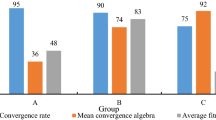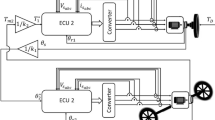Abstract
In this paper, an integrated condition monitoring method combining model-based fault diagnosis and data-driven prognosis is proposed for steer-by-wire (SBW) system. First, the SBW system is modeled by bond graph (BG) technique and a two-degree-of-freedom (2-DOF) state-space model of the vehicle is built. Based on the 2-DOF model, the estimated self-aligning torque is used for the control of feedback motor. The fault detection is carried out by evaluating the analytical redundancy relations derived from the BG model. Since the fault isolation performance is essential to subsequent fault estimation process, a new fault isolation method based on finite state machine is developed to improve the isolation ability by combining the dependent and independent analytical redundancy relations, where the number of potential faults could be decreased. In order to refine the possible fault set to determine the true fault, a cuckoo search (CS)–particle filter is developed for fault estimation. Based on the estimated true fault, prognosis can be implemented which is important to achieve failure prevention and prolong system lifespan. To this end, an optimized extreme learning machine (OELM) is proposed where the input weights and hidden layer biases are optimized by CS. Based on data representing fault values obtained from the fault identification, the OELM model is trained for remaining useful life prediction of failing component. Finally, the proposed methodologies are validated by simulations.











Similar content being viewed by others
References
Zhang J, Wang H, Zheng J et al (2020) Adaptive sliding mode-based lateral stability control of steer-by-wire vehicles with experimental validations. IEEE Trans Veh Technol 69:9589–9600
Huang C, Naghdy F, Du H, Huang H (2019) Fault tolerant steer-by-wire systems: an overview. Annu Rev Control 47:98–111
Gadda C, Laws S, Gerdes J (2007) Generating diagnostic residuals for steer-by-wire vehicles. IEEE Trans Control Syst Technol 15:529–540
Xue T, Zhong M, Li L, Ding S (2020) An optimal data-driven approach to distribution independent fault detection. IEEE Trans Ind Inf 16:6826–6836
Zhao Z, Xu Q, Jia M (2016) Improved shuffled frog leaping algorithm-based BP neural network and its application in bearing early fault diagnosis. Neural Comput Appl 27:375–385
Prakash O, Samantaray A, Bhattacharyya R (2019) Model-based diagnosis of multiple faults in hybrid dynamical systems with dynamically updated parameters. IEEE Trans Syst Man Cybern-Syst 49:1053–1073
Yu M, Xiao C, Jiang W et al (2018) Fault diagnosis for electromechanical system via extended analytical redundancy relations. IEEE Trans Ind Inf 14:5233–5244
Han W, Wang Z, Shen Y, Xu B (2021) Interval estimation for uncertain systems via polynomial chaos expansions. IEEE Trans Autom Control 66:468–475
Xu B, Shi Z, Sun F, He W (2019) Barrier Lyapunov function based learning control of hypersonic flight vehicle with AOA constraint and actuator faults. IEEE T Cybern 49:1047–1057
Daigle M, Koutsoukos X, Biswas G (2009) A qualitative event-based approach to continuous systems diagnosis. IEEE Trans Control Syst Technol 17:780–793
Zhao J (2018) Dynamic state estimation with model uncertainties using H∞ extended Kalman filter. IEEE Trans Power Syst 33:1099–1110
Partovibakhsh M, Liu G (2015) An adaptive unscented Kalman filtering approach for online estimation of model parameters and state-of-charge of lithium-ion batteries for autonomous mobile robots. IEEE Trans Control Syst Technol 23:357–363
Yu M, Xia H, He Y et al (2017) Scheduled health monitoring of hybrid systems with multiple distinct faults. IEEE Trans Ind Electron 64:1517–1528
Huang C, Yin X, Huang H, Li Y (2020) An enhanced deep learning-based fusion prognostic method for RUL prediction. IEEE Trans Reliab 69:1097–1109
Hu Q, Qin A, Zhang Q et al (2018) Fault diagnosis based on weighted extreme learning machine with wavelet packet decomposition and KPCA. IEEE Sens J 18:8472–8848
Hu Y, Wang H, Cao Z et al (2020) Extreme-learning-machine-based FNTSM control strategy for electronic throttle. Neural Comput Appl 32:14507–14518
Zhang J, Wang H, Cao Z et al (2019) Fast nonsingular terminal sliding mode control for permanent magnet linear motor via ELM. Neural Comput Appl 32:14447–14457
Ye M, Wang H (2020) Robust adaptive integral terminal sliding mode control for steer-by-wire systems based on extreme learning machine. Comput Electr Eng 86:445–452
Hu Y, Wang H (2020) Robust tracking control for vehicle electronic throttle using adaptive dynamic sliding mode and extended state observer. Mech Syst Signal Process 135:1–18
Zhang J, Wang H, Ma M et al (2020) Active front steering-based electronic stability control for steer-by-wire vehicles via terminal sliding mode and extreme learning machine. IEEE Trans Veh Technol. https://doi.org/10.1109/TVT.2020.3036400
Yamaguchi Y, Murakami T (2009) Adaptive control for virtual steering characteristics on electric vehicle using steer-by-wire system. IEEE Trans Ind Electron 56:1585–1594
Yang X, Deb S (2013) Cuckoo search: recent advances and applications. Neural Comput Appl 24:169–174
Pan Z, Meng Z, Chen ZJ et al (2020) A two-stage method based on extreme learning machine for predicting the remaining useful life of rolling-element bearings. Mech Syst Signal Proc 144:106899–106916
Zhao Z, Feng X, Lin Y et al (2013) Improved rao-blackwellized particle filter by particle swarm optimization. J Appl Math 20:1–7
Sun W, Wang C, Zhang C (2017) Factor analysis and forecasting of CO2 emissions in Hebei, using extreme learning machine based on particle swarm optimization. J Clean Prod 20:1095–1101
Karystinos G, Pados D (2000) On overfitting, generalization, and randomly expanded training sets. IEEE Trans Neural Netw Learn Syst 11:1045–1053
Yu H, Sun X, Wang J (2019) A dynamic ELM with balanced variance and bias for long-term online prediction. Neural Process Lett 49:1257–1271
Ning K, Liu M, Dong M et al (2015) Two efficient twin ELM methods with prediction interval. IEEE Trans Neural Netw Learn Syst 26:2058–2071
Xiao Y, Li J, Zhu Y et al (2020) User behavior prediction of social hotspots based on multimessage interaction and neural network. IEEE Trans Comput Social Syst 7:536–546
Author information
Authors and Affiliations
Corresponding author
Ethics declarations
Conflict interest
The authors declare that they have no conflict of interest.
Additional information
Publisher's Note
Springer Nature remains neutral with regard to jurisdictional claims in published maps and institutional affiliations.
Rights and permissions
About this article
Cite this article
Lan, D., Yu, M., Huang, Y. et al. Fault diagnosis and prognosis of steer-by-wire system based on finite state machine and extreme learning machine. Neural Comput & Applic 34, 5081–5095 (2022). https://doi.org/10.1007/s00521-021-06028-0
Received:
Accepted:
Published:
Issue Date:
DOI: https://doi.org/10.1007/s00521-021-06028-0




